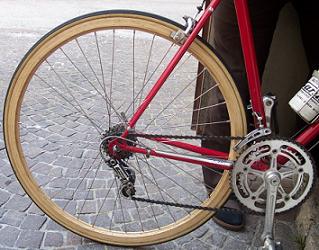 Wooden rims Wooden rims
Most cyclists will agree that the one thing which improves the
performance of any bike (apart from a good pair of legs!) is a good
pair of wheels. For a while, Les rode a pair of 'cane'
wheels. Basically - wooden rims (bamboo cane)! Those
particular rims were manufactured by a firm called Constrictor, who
also made the tubeless tyres to go with them, and he says they were
incredibly light (for the day).
Now these rims were designed for
track racing, but a few time-triallists of his day couldn't resist
using them on the road. Of course braking was a problem, but as
Les points out, in a time-trial, braking tends to be a bad thing ;-)
and of course he was on a 'proper' bike with fixed wheel, which means
braking is cut to an absolute minimum. If you want to slow down,
you use your legs - simple.
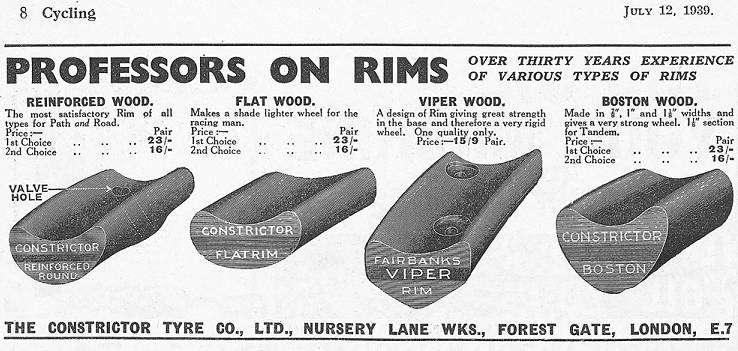
Above
is an advert from Cycling magazine (July 1939) showing samples of some
of the wooden Constrictor rims available at the time - even one
designed for a tandem!
It just so happens that my good
friend Sergio Servadio from Pisa, Italy has made two pairs
of wooden rims. One for the FANINI bike manufacturer, who
renovated an old racing cycle and wanted them for display purposes,
and one pair for himself. He's kindly sent me the
following text and pictures describing the 'manufacturing process'.
Let me just say, this is a talented chap - he even
makes his own corned beef!
Here's Sergio's text (It
gives the phrase 'building your own wheels' a whole new meaning ;-)
Granted that bamboo cane
cannot be beaten, so far I made 5-ply constructions of 3-4 mm thick
laminas, the first 4 of ash and the fifth one of walnut wood. These
woods are suitable and 'by chance' I happened to have them about ready
to use in my shed. Such thickness can be bent with no heat, nor
moisture. The laminas were about 2/3 of the circumference long taking
care not to superimpose successive matchings.
After the fifth lamina I have 'trued' the outer circle by making the
rims (embracing a smaller wheel mounted on a vice held fork) turn
against a belt sander.
Now comes the tougher part of the job. I have to apply the last outer
lamina, likely walnut, of a 7 mm thickness which cannot be so easily
bent and glued in place. I insist on this thickness because I later
have to make the seating of the tubular by working on it with a
router, and I deem that a thinner thickness would be unsuitable to the
ultimate job.
At last I shall also mould the inner face, burn in groves, double lace
with a thread running in the groves and seal everything.
I just could not resist making only the wheels for the antique bike
Fanini wants to renovate, so decided to make one set to use myself on
Monte Serra - after due testing of course.
For the fun of it.
And, yes, it is great fun!
More news ahead ...
Sergio.
Pisa
 |
Truing the outer circle after
applying the 5th lamina. |
| Applying the outer 7mm thick
lamina of walnut. |
 |
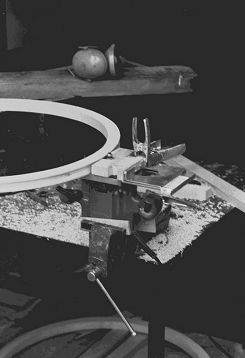 |
Routing out the seating for
the tubular. |
| The finished rim prior to drilling the spoke holes. |
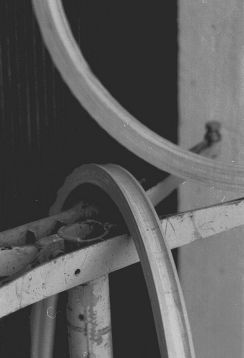 |
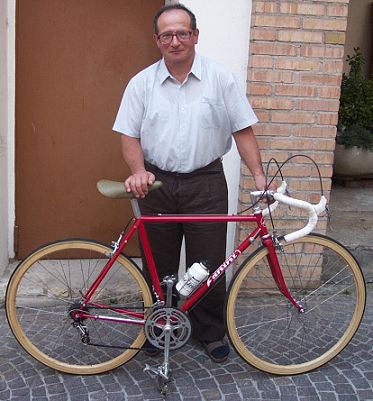 |
The finished product!
(Note: The brake blocks are home made
too - made of leather. Conventional blocks 'squealed' too
much.
The downside of that is that the blocks
wear out very quickly. One descent of the Croce d'Aune was
enough to wear them down completely!)
|
|